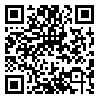1. Dick DM, Hancock LC. Integrating basic research with prevention/intervention to reduce risky substance use among college students. Front Psychol. 2015;6:544. [
DOI]
2. Perski O, Herd N, West R, Brown J. Perceived addiction to smoking and associations with motivation to stop, quit attempts and quitting success: A prospective study of English smokers. Addictive Behaviors. 2019;90:306–11. [
DOI]
3. Bassak Nejad S, Hatami Sarbarzeh M, Zargar Y. The effect of cognitive behavioral group therapy on thought- action fusion, thought suppression and guilt feeling of university students. Journal of Behavioral Sciences 2013;7(1):7–12. [Persian] [
Article]
4. Garcia OF, Serra E, Zacares JJ, Calafat A, Garcia F. Alcohol use and abuse and motivations for drinking and non-drinking among Spanish adolescents: do we know enough when we know parenting style? Psychol Health. 2020;35(6):645–64. [
DOI]
5. Harandi V, Soltani A, Manzari Tavakoli A, Zeinadini Z. The role of marital satisfaction and parenting style in function reading in children with specific learning disorder. Middle Eastern Journal of Disability Studies. 2018;8:62. [Persian] [
Article]
6. Habibi M, Haji Sheykhi M, Lavaf H. The relationship between paternal lifestyle and parenting style: the role of father's drug addiction. Iranian Journal of Psychiatry and Clinical Psychology. 2016;21(4):297–307. [Persian] [
Article]
7. Berge J, Sundell K, Öjehagen A, Hakansson A. Role of parenting styles in adolescent substance use: results from a Swedish longitudinal cohort study. BMJ Open. 2016;6(1):e008979. [
DOI]
8. Vahid B. The predicted role of parenting styles in man treated for substance abuse. J Neurosurgery and Neurology Research. 2020;1(1).1-3. doi: [
DOI]
9. Clarke PB, Lewis TF, Myers JE, Henson RA, Hill B. Wellness, emotion regulation, and relapse during substance use disorder treatment. Journal of Counseling & Development. 2020;98(1):17–28. [
DOI]
10. Abooie B, Amiri M. Relationship between perceived stress, frustration tolerance, cognitive emotion regulation with depression syndrome. Middle Eastern Journal of Disability Studies. 2019;9:79. [Persian] [
Article]
11. McKee K, Russell M, Mennis J, Mason M, Neale M. Emotion regulation dynamics predict substance use in high-risk adolescents. Addict Behav. 2020;106:106374. [
DOI]
12. Wilcox CE, Pommy JM, Adinoff B. Neural circuitry of impaired emotion regulation in substance use disorders. Am J Psychiatry. 2016;173(4):344–61. [
DOI]
13. Sloan E, Hall K, Moulding R, Bryce S, Mildred H, Staiger PK. Emotion regulation as a transdiagnostic treatment construct across anxiety, depression, substance, eating and borderline personality disorders: a systematic review. Clin Psychol Rev. 2017;57:141–63. [
DOI]
14. Krejcie RV, Morgan DW. Determining sample size for research activities. Educational and Psychological Measurement. 1970;30(3):607–10.
15. Baumrind D. Effective parenting during the early adolescent transition. In: Cowan PA, Hetherington M; editors. Family transitions. Hillsdale, NJ: Lawrence Erlbaum Associates, Inc; 1991.
16. Minaei A, Nikzad S. The factor structure and validity of the Persian version of the Baumrind Parenting Style Inventory. Journal of Family Research. 2017;13(1):92–108. [Persian]
17. Garnefski N, Kraaij V, Spinhoven P. Negative life events, cognitive emotion regulation, and emotional problems. Personality and Individual Differences. 2001;30:1311–27. doi: [
DOI]
18. Khoshzamir Sh, Binesh M. Rabeteye beyn rahbord haye tanzime shenakhti hayajan va khallaghiat hayajani be behdasht ravani daneshjouyan [The relationship between cognitive emotion regulation strategies and emotional creativity with mental health of students]. Journal of Research in Educational Sciences. 2016;10(33):85–100. [Persian] [
Article]
19. Weed NC, Butcher JN, McKenna T, Ben-Porath YS. New measures for assessing alcohol and drug abuse with the MMPI-2: the APS and AAS. J Pers Assess. 1992;58(2):389–404. [
DOI]
20. Zargar Y, Najarian B, Naami AZ. Barrasiye rabetey vizhegi haye shakhsiati (hayajan khahi, ebraz vojoud, sarsakhti ravanshenakhti), negaresh mazhabi va rezayat zanashooei ba amadegi etiad be mavad mokhaddar dar karkonan yek Sherkat sanati dar Ahvaz [The relationship of some personality variables, religious attitudes and marital satisfaction with addiction potential in personnel of an industrial factory in Ahvaz]. Journal of Educaton and Psychology. 2008;15(1):99–120. [Persian]
21. Ahmadi V, Banijamali Sh, Sarami Gh. The relationship between parenting styles and addiction potentiality in Ilam high school students: the mediating role of novelty seeking. Journal of Ilam University of Medical Sciences. 2017;25(3):117–24. [Persian] [
DOI]
22. Zeinali A, Vahdat R, Garadingeh K. The relationship between parenting style and addiction susceptibility in children. Journal of Family Research. 2010;6(3):335–52. [Persian] [
Article]
23. Sadri Demirchi E, Kiani A. The prediction of tendency to addiction based on social self-esteem and cognitive emotion regulation in university students. Culture in The Islamic University. 2018;8(2):289–306. [Persian] [
Article]
24. Sepehri M, Kiani Q. The relationship between cognitive emotion regulation and addiction tendency: the mediating roles of social and emotional loneliness and early maladaptive schemas. Etiadpajohi. 2020;14(56):313–38. [Persian] [
DOI]





